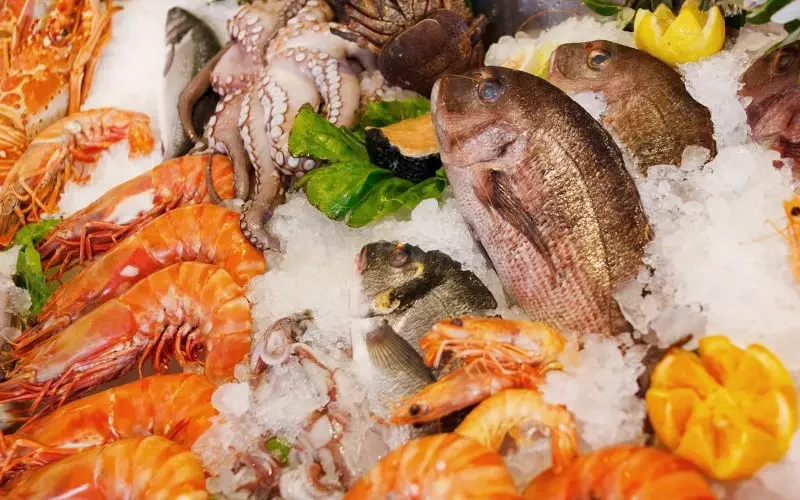Seafood Southeast Asia
For residents of the coastal regions of Southeast Asia, seafood is not some kind of delicacy. It is their daily food in addition to rice. Every morning, fishermen bring their catch to the fish market. There are already buyers waiting for them. Restaurants buy selected specimens of seafood. Gourmet dishes will be prepared from them today.
Fish
The variety of fish species on the market is dizzying. All kinds of colors and sizes. There are truly amazing specimens. Fish-ball, studded with thorns. Serpentine eels. Gars with a long and thin, like a needle, nose. Silvery, shimmering blue, tuna. Flat and long like sabers, barracudas, with a toothy mouth. Stingrays, similar to unknown monsters. All the names, not only to remember, but also difficult to pronounce. Probably, pricing is based on the difficulty of catching and the taste of the fish, and not their size. Even large tuna are no more expensive than small snappers. But a small multi-colored fish, judging by the price, has almost no commercial value.
If you want fish even fresher than on the market, you will either have to catch it yourself, or wake up early and come to the sea to meet fishing boats. They have a catch that has not yet been sorted in huge foam plastic boxes, covered with ice. Small tunas and mackerels lie interspersed with long, saber-like laurels and winged flying fish. It is possible and worth bargaining with fishermen. The freshest fish can be bought twice cheaper than in the market.
In the fish markets, you can not only choose a product, but also find a place where you will cook the purchased delicacy. If you are not in a hurry, you can order grilled. A fish planted on a thin bamboo stick will languish for a long time over coals from a coconut shell, spreading a delicious aroma. And if you want to quickly start a meal, then there are grates and a strong fire for this. Spread fish is smeared with special sauces and more often turned over over the fire. In order not to overdry the meat and prevent the fish from burning on the outside, it is additionally smeared with sauce during the cooking process. With such a seemingly simple method of cooking, you get a delicious dish. If you want something more refined, then it is better to go to a restaurant. Every fish is good with the right choice of preparation. Some are better to cook or stew, some taste better fried or grilled. In this matter, trust the local chefs.
Squid, cuttlefish and octopus
The banal statement that pure protein is found in squid, cuttlefish and other cephalopods will not impress anyone. But to see a live octopus on the counter is a completely different matter. When touched, the tentacles change color. And if you touch the suction cups, they noticeably “stick” to your fingers. Cuttlefish and squid in the markets of Southeast Asia have never known frost. Always a fresh product that comes straight from the sea to the table. Only here you can feel the real taste of cephalopods.
The locals prepare them in the simplest way. It is so simple that the chefs do not even consider it necessary to clean and gut the carcasses. They are simply strung on bamboo skewers and roasted over coals. They are pre-soaked in a marinade or periodically coated with a special sauce during cooking. To try cephalopods in coconut milk, you need to go to more serious food outlets than a simple roaster with coconut coals.
Crabs, shrimps, lobsters
Such a large selection of crustaceans can only be seen in the markets of Southeast Asia. Frozen shrimp, which are familiar to us, rattling with icicles, cannot be found here. Everything is alive and fresh, just taken out of the water. In order for the buyer to see the product in all its glory, there are basins of water on the floors, in which shrimp swarm. Small specimens are salted, dried and used for seasoning. They are not even sold in a living form, but immediately allowed for processing. Large shrimp may not necessarily be from the sea. Now many farms have been created to breed this delicacy. On the one hand, the demand for shrimp is ensured, and on the other hand, the natural ecological system is not harmed. Price stability does not depend on whether the catch was successful or not.
Large shrimp are used to prepare various gourmet dishes. Just boiled shrimp can not even be considered. You can also eat them at home. In Indonesia, for example, you have the opportunity to try grilled shrimp. Shrimps of medium size are cut from the back and smeared with chili sauce. They are laid on a grate, and after several turns over the coals, an excellent delicacy is obtained. In Thailand, you can try king prawns in coconut milk sauce. Each seaside restaurant has its own special shrimp dish.
Crabs are ubiquitous in the fish markets of Southeast Asia. They are very similar in size and appearance. Even the price is about the same. But if you compare the crabs of Indonesia , the Philippines , Thailand , Vietnam or Cambodia , then Cambodian blue crabs from the small town of Kep will have the palm. In Vietnam, you can try relic horseshoe crabs. They don’t even look like crabs. Some kind of shell on legs with a long thin tail.
Many come to Southeast Asia to taste the finest lobsters. But very often lobsters are mistaken for them. In order not to get confused, you just need to remember that a lobster is a large sea cancer. With claws. Just like our regular freshwater crayfish. Only the size is bigger. And the spiny lobster is more like a huge shrimp. But in this case, the name is not so important, the main thing is the taste of the dish. It’s just that when you choose a crustacean creature in a restaurant aquarium, don’t confuse the names.
Oysters and other shellfish
Of the shells presented at the fish markets, only oysters have an international name. Other mollusks may have their own local names. Often they can not be remembered. Because in other cities and countries they may be called differently, or even completely absent. But there will be shells peculiar to that region. In terms of taste, they are almost all the same. The variety of flavors will depend on the chefs who prepare them.
The range of edible shells in the markets consists of two types. Oysters, mussels and the like are called bivalves. And the shells twisted in a spiral that crawl along the bottom are called gastropods. Their freshness can be seen immediately. Bivalves lie, poured in small heaps, on trays of water. From time to time, then one, then another shell splashes in a small trickle. Gastropods are in constant motion. And sellers have to vigilantly monitor their goods so that they do not scatter far. Sometimes they sell the pulp of mollusks already extracted from the shells.
In the Philippines, you can often see some kind of yellowish mass in flat glass rum bottles in fish markets. This is the meat of sea urchins. In an outwardly large “shell”, there are only a few narrow strips of “meat” on the walls of the shell. To fill one such bottle, you need more than a dozen marine echinoderms.
Sea cucumbers, frogs and more
In the fish markets you can meet many exotic animals. For example, sea cucumbers. They are also called trepangs and cucumaria. In terms of nutritional and beneficial properties, they can be compared with ginseng root. Sometimes they are called so – the sea root of life. But it is not a frequent visitor in most markets. Only in those places where their industrial fishing is carried out.
Frogs, of course, are not marine animals, but are sold on the same rows as seafood. Large amphibians sit in large baskets with a lid. They can hardly fit in the palm of your hand. So that buyers do not bother with cleaning, they cut up your carcass here in the market, gut it and remove the skin. You will receive a carcass, the size of a quail. But cooking is best left to professionals.
In Vietnamese fish markets, you can sometimes see whole bowls of starfish for sale. It is unlikely that they are sold for food. Most likely to be added to various tinctures. And the Vietnamese know a lot about such tinctures. It is even difficult to imagine such a number of floating and crawling reptiles in one bottle, unless you yourself see a battery of vessels with all kinds of living creatures. And the constant element in such tinctures will be starfish.
Seafood in Southeast Asia is distinguished not only by its variety and relatively low price, but, most importantly, by its freshness. Seafood comes from its element to your table in just a few hours. Here you can feel the real taste of seafood, not spoiled by freezing and long-term storage. And just walking through the fish market will be interesting. It’s like a museum, but all the exhibits are alive and real. It’s like a zoo, but you can buy and try any presented specimen if you want. This is a mass of new impressions that will stay with you forever.









